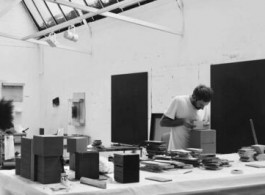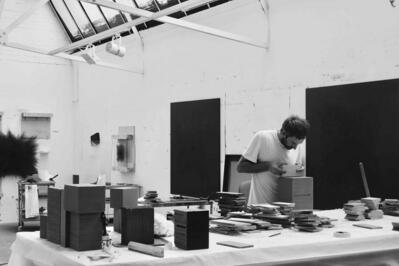“Absorbing Light”
Victoria Miro
Victoria Miro is delighted to announce an exhibition of new work by Idris Khan.
Comprising a monumental sculpture, a multi-part installation, paintings of geometric and stripe formations, and works on paper, Absorbing light is the most comprehensive exhibition by the artist in London in four years. It marks an important departure for Khan, who will show works in bronze for the first time along with an entirely abstract painting. Uniting aesthetic and metaphysical questions, Khan has often employed techniques of layering and repetition to realise fragmentary experience or disparate ideas as a single image or solid form. In these new works, two- and three-dimensional forms are triggered by a desire to ascertain how scale, mass and volume are perceived, measured or remembered in times of sensory deprivation or through compromised and fragmentary accounts.
A four-metre-square sculpture composed of fifteen columns, each painted a light-absorbing black to achieve a fathomless darkness, on initial impression reads as a solid, impenetrable mass rising up towards the ceiling. Upon closer inspection, as viewers’ eyes adjust, its interior structure is revealed as natural light travels through small spaces between each column. Always sensitive to the notion of scale, in particular the scale of a human body in relation to space, in this work Khan marries aesthetic beauty with a sense of disorientation and physical exclusion – heightening the anxiety a spectator might feel when unable to ascertain their surroundings.
A painting, three-and-a-half metres in length, is composed solely of alternating bars of light and dark black, subtly modulated to suggest surface and depth. Created to disrupt perception, the work accentuates the ways in which eye and mind can be tricked by a simple image into to seeing lights, lines, after images and shadows. The stripes, like bars, bring to mind thoughts of incarceration, while the interference patterns and strobing sensations, redolent of op-art, are suggestive of altered emotional or psychological states. In this work, Khan refers to the artistic lineage of the monochrome. Rather than reject representation, however, he embraces its complications and possibilities.
In fact, both painting and sculpture allude to spaces of imprisonment and the experiences of those whose perception has been compromised. Deeply moved by testimonies from Saydnaya, Syria’s most notorious and brutal prison, Khan has researched the ways in which inmates encounter and remember their surroundings. While first-hand accounts of Saydnaya, where cells intended for solitary confinement are inhabited by up to fifteen detainees, are the only available source of information about the prison, the testimonies of those few inmates who are released are severely hampered by the conditions in which they are kept: in darkness, blindfolded, or forced to cover their eyes. Their sense of the place, therefore, can only be ascertained by other means – through sound, smell, or by mental exercises such as counting the tiles on a floor, the bars of a cell, the number of fellow prisoners, or the number of days detained. Darkness unites the works – both physical darkness and the metaphorical and emotional darkness of his source material.
Words taken from stories or testimonies from conflict, and also Khan’s personal responses to them, are incorporated into a patinated cast bronze floor piece comprising 44 blocks of various dimensions, each stamped with numbers and texts, and distributed in seemingly random configurations. The work is influenced in part by the language of minimalism. However, unlike the minimalists, for whom mathematical order and purity were bulwarks against darker forces of entropy and disorder, Khan brings into play a host of fragmentary voices and contradictory readings: on the one hand, quantifiable geometric form; on the other, immeasurable subjective experience. Texts are further incorporated into monochrome paintings made with large-scale stamps, applied repetitively to the surface of the canvas in radial formations. In these intensely visceral works, where addition and erasure become as one, Khan pushes his subject matter to the cusp of legibility.
Works on Japanese paper, cast in resin to achieve maximum translucency, are displayed on plinths between sheets of Plexiglas, questioning their own materiality and status as objects. Together, the works on display offer a sustained consideration of light and its absence, form and formlessness, rational and irrational thought, in addition to an ever-changing viewing experience as they are acted upon by the ambient light that floods Gallery II, Wharf Road.




